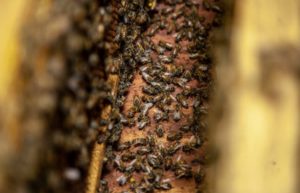Green Carpenter Bees Removal
Introduction
Xylocopa aerata, the golden-green carpenter bee, is one of two species of carpenter bee found in the Sydney region of New South Wales in Australia. It gets its common name by its habit of burrowing into wood.It was originally described by F. Smith in 1851 as Lestis aeratus.Its specific epithet is the Latin adjective aerata, meaning “bronzed”.As its name implies, the Golden-green carpenter bee is a metallic green in colour, although it may appear purplish or bluish from some angles. A large stocky bee, it is often heard by its loud low-pitched buzzing while flying between flowers. The male has yellow face markings. The bee does have a sting which is potentially painful, although no stings have been recorded.

Why their removal is necessary?
Green Carpenter do not spread diseases or infections; however, they can still be dangerous. The danger with carpenter ants comes from the fact that they make their nests in wood. If they choose your home for their nest, they can cause serious structural damage.
How to Get Rid of Green Carpenter Bees Fast?
Some Methods to remove Green Carpenter Bees:
- The best way to get rid of Green carpenter bees is to call a pest control professional. The most common treatment we use is a powdered insecticide puffed up into each hole. This eradicates the bees themselves and the eggs as well.The best time to treat for these bees is in the spring. It’s best to treat when you first notice them buzzing around your wood trim pieces. A second treatment in the summer is a good idea, just in case the first treatment didn’t get all the eggs.
- If you find a hive and want the bees to relocate without killing them, consider sprinkling cinnamon around their hive every day for about a week. The smell will send the bees looking for a place to relocate.
- Vinegar spray is a great natural way to get the bee out of your yard, as well as simple to make and use. Just mix equal amounts of water and vinegar in a spray bottle, shake and the mixture on the nest when the bees are sleeping, at night, as well as around plants where you tend to see a lot of bees. This mixture will kill the bees so make sure you remove all of the dead bees.
- call the bee control Melbourne experts of Bees Removal Melbourne on 03 9021 3752.






